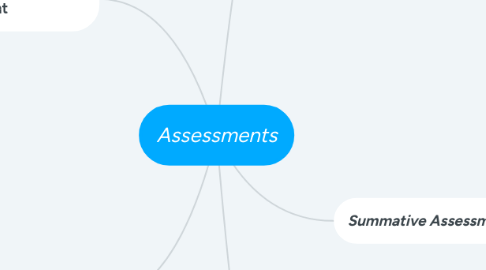
1. Informative/ Formative Assessment
1.1. Allows educators to evaluate and monitor student learning and provide proficient and continuous feedback.
1.2. It helps students identify strengths, weaknesses, and other needs to improve their learning.
1.3. Informative/ Formative Assessment Strategies
1.3.1. Venn Diagram
1.3.2. Three Questions
1.3.3. Think-Pair-Share
1.3.4. Exit/Admit Tickets
1.3.5. multiple choice assessment
1.3.6. End-of-unit or -chapter tests
2. Data collection
2.1. Diagnostic Assessment Data
2.1.1. Data generated provides educators with data to adjust instructions, reteach specific content and concepts during instructional time.
2.2. Informative/ Formative Assessment Data
2.2.1. Data generated can be used by instructors to improve their teaching and by students to enhance their learning.
2.3. Criterion-referenced assessment
2.3.1. The data generated provides educators with the ability to comprehend instruction and advance in the classroom.
2.4. Summative Assessment
2.4.1. Benchmark scores and data generated encourage students' learning abilities by comparing themselves to their contemporaries.
3. Diagnostic Assessment
3.1. Provides educators with data to adjust instruction and curriculum before instructional time.
3.2. It assists in locating students' misunderstandings or difficulties in a specific lesson.
3.3. Assess students' abilities and understanding before the lesson is instructed.
3.4. A strategy for educators to collect critical information of students' learning abilities, styles of learning, and weaknesses prior to instruction.
3.5. Diagnostic Assessment Strategies
3.5.1. Traditional tests
3.5.1.1. multiple choice assessment
3.5.1.2. True-False assessment
3.5.2. Teacher prepared pretests
3.5.3. KWL charts and other graphic organizers
3.5.4. Concept Maps
3.5.5. Guess Box
4. Summative Assessment
4.1. Enables educators with the ability to assess and evaluate students' strengths and weaknesses cumulatively and the end of an unit.
4.2. Educators assess students' learning abilities at the end of instructions and compare and contrast it against to curriculum's standards.
4.3. Benchmark scores and data generated encourage students' learning abilities by comparing themselves to their contemporaries.
4.4. Teachers and the organization can collect data to decide if instructions, learning, and classroom strategies are encouraging and promising.
4.5. Summative Assessment Strategies
4.5.1. Standardized tests
4.5.1.1. multiple choice assessment
4.5.1.2. True-False assessment
4.5.1.3. End-of-unit or -chapter tests
4.5.2. Instructor-created exams
4.5.3. End-of-term or midterm exams
4.5.4. Final Projects
4.5.5. Portfolios
5. Criterion-referenced assessment
5.1. Provides educators with the ability to assess how students are comprehending the instructions and advancing in the classroom.
5.2. Assess and measure the performance of students against the content and instruction covered in the curriculum.
5.3. Enable educators to instruct specific skills and content that students can comprehend and assess them on a particular standard.
5.4. Criterion-referenced assessment strategies
5.4.1. Standardized tests
5.4.1.1. Measure learning for a particular student.
5.4.2. Traditional tests
5.4.3. End-of-term or midterm exams
